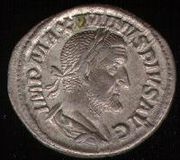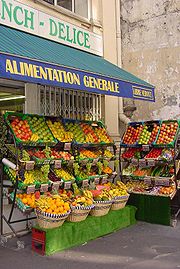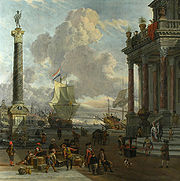
Trade
About this schools Wikipedia selection
SOS Children has tried to make Wikipedia content more accessible by this schools selection. SOS Children has looked after children in Africa for forty years. Can you help their work in Africa?
Trade is the voluntary exchange of goods, services, or both. Trade is also called commerce. A mechanism that allows trade is called a market. The original form of trade was barter, the direct exchange of goods and services. Modern traders instead generally negotiate through a medium of exchange, such as money. As a result, buying can be separated from selling, or earning. The invention of money (and later credit, paper money and non-physical money) greatly simplified and promoted trade. Trade between two traders is called bilateral trade, while trade between more than two traders is called multilateral trade.
Trade exists for many reasons. Due to specialisation and division of labor, most people concentrate on a small aspect of production, trading for other products. Trade exists between regions because different regions have a comparative advantage in the production of some tradable commodity, or because different regions' size allows for the benefits of mass production. As such, trade at market prices between locations benefits both locations.
Trading can also refer to the action performed by traders and other market agents in the financial markets.
History of trade
Trade originated with the start of communication in prehistoric times. Trading was the main facility of prehistoric people, who bartered goods and services from each other before the innovation of the modern day currency. Peter Watson dates the history of long-distance commerce from circa 150,000 years ago.
Trade is believed to have taken place throughout much of recorded human history. There is evidence of the exchange of obsidian and flint during the stone age. Materials used for creating jewelry were traded with Egypt since 3000 BC. Long-range trade routes first appeared in the 3rd millennium BC, when Sumerians in Mesopotamia traded with the Harappan civilization of the Indus Valley. The Phoenicians were noted sea traders, traveling across the Mediterranean Sea, and as far north as Britain for sources of tin to manufacture bronze. For this purpose they established trade colonies the Greeks called emporia. From the beginning of Greek civilization until the fall of the Roman empire in the 5th century, a financially lucrative trade brought valuable spice to Europe from the far east, including China. Roman commerce allowed its empire to flourish and endure. The Roman empire produced a stable and secure transportation network that enabled the shipment of trade goods without fear of significant piracy.
The fall of the Roman empire, and the succeeding Dark Ages brought instability to Western Europe and a near collapse of the trade network. Nevertheless some trade did occur. For instance, Radhanites were a medieval guild or group (the precise meaning of the word is lost to history) of Jewish merchants who traded between the Christians in Europe and the Muslims of the Near East.
The Sogdians dominated the East-West trade route known as the Silk Road after the 4th century AD up to the 8th century AD, with Suyab and Talas ranking among their main centeres in the north. They were the main caravan merchants of Central Asia.
From the 8th to the 11th century, the Vikings and Varangians traded as they sailed from and to Scandinavia. Vikings sailed to Western Europe, while Varangians to Russia. The Hanseatic League was an alliance of trading cities that maintained a trade monopoly over most of Northern Europe and the Baltic, between the 13th and 17th centuries.
Vasco da Gama restarted the European Spice trade in 1498. Prior to his sailing around Africa, the flow of spice into Europe was controlled by Islamic powers, especially Egypt. The spice trade was of major economic importance and helped spur the Age of Exploration. Spices brought to Europe from distant lands were some of the most valuable commodities for their weight, sometimes rivaling gold.
In the 16th century, Holland was the centre of free trade, imposing no exchange controls, and advocating the free movement of goods. Trade in the East Indies was dominated by Portugal in the 16th century, the Netherlands in the 17th century, and the British in the 18th century. The Spanish Empire developed regular trade links across both the Atlantic and the Pacific Oceans.
In 1776, Adam Smith published the paper An Inquiry into the Nature and Causes of the Wealth of Nations. It criticised Mercantilism, and argued that economic specialisation could benefit nations just as much as firms. Since the division of labour was restricted by the size of the market, he said that countries having access to larger markets would be able to divide labour more efficiently and thereby become more productive. Smith said that he considered all rationalisations of import and export controls "dupery", which hurt the trading nation at the expense of specific industries.
In 1799, the Dutch East India Company, formerly the world's largest company, became bankrupt, partly due to the rise of competitive free trade.
In 1817, David Ricardo, James Mill and Robert Torrens showed that free trade would benefit the industrially weak as well as the strong, in the famous theory of comparative advantage. In Principles of Political Economy and Taxation Ricardo advanced the doctrine still considered the most counterintuitive in economics:
- When an inefficient producer sends the merchandise it produces best to a country able to produce it more efficiently, both countries benefit.
The ascendancy of free trade was primarily based on national advantage in the mid 19th century. That is, the calculation made was whether it was in any particular country's self-interest to open its borders to imports.
John Stuart Mill proved that a country with monopoly pricing power on the international market could manipulate the terms of trade through maintaining tariffs, and that the response to this might be reciprocity in trade policy. Ricardo and others had suggested this earlier. This was taken as evidence against the universal doctrine of free trade, as it was believed that more of the economic surplus of trade would accrue to a country following reciprocal, rather than completely free, trade policies. This was followed within a few years by the infant industry scenario developed by Mill promoting the theory that government had the "duty" to protect young industries, although only for a time necessary for them to develop full capacity. This became the policy in many countries attempting to industrialise and out-compete English exporters. Milton Freidman later continued this vein of thought, showing that in a few circumstances tariffs might be beneficial to the host country; but never for the world at large.
The Great Depression was a major economic recession that ran from 1929 to the late 1930s. During this period, there was a great drop in trade and other economic indicators.
The lack of free trade was considered by many as a principal cause of the depression. Only during the World War II the recession ended in United States. Also during the war, in 1944, 44 countries signed the Bretton Woods Agreement, intended to prevent national trade barriers, to avoid depressions. It set up rules and institutions to regulate the international political economy: the International Monetary Fund and the International Bank for Reconstruction and Development (later divided into the World Bank and Bank for International Settlements). These organisations became operational in 1946 after enough countries ratified the agreement. In 1947, 23 countries agreed to the General Agreement on Tariffs and Trade to promote free trade.
Free trade advanced further in the late 20th century and early 2000s:
- 1992 European Union lifted barriers to internal trade in goods and labour.
- January 11994 NAFTA took effect
- 1994 The GATT Marrakech Agreement specified formation of the WTO.
- January 11995 World Trade Organization was created to facilitate free trade, by mandating mutual most favoured nation trading status between all signatories.
- EC was transformed into the European Union, which accomplished the Economic and Monnetary Union (EMU) in 2002, through introducing the Euro , and creating this way a real single market between 13 member states as of January 1, 2007.
- 2005, the Central American Free Trade Agreement was signed; It includes the United States and the Dominican Republic.
Development of money
The first instances of money were objects with intrinsic value. This is called commodity money and includes any commonly-available commodity that has intrinsic value; historical examples include pigs, rare seashells, whale's teeth, and (often) cattle. In medieval Iraq, bread was used as an early form of money. In Mexico under Montezuma cocoa beans were money.

Currency was introduced as a standardised money to facilitate a wider exchange of goods and services. This first stage of currency, where metals were used to represent stored value, and symbols to represent commodities, formed the basis of trade in the Fertile Crescent for over 1500 years.
Numismatists have examples of coins from the earliest large-scale societies, although these were initially unmarked lumps of precious metal.
Ancient Sparta minted coins from iron to discourage its citizens from engaging in foreign trade.
The system of commodity money in many instances evolved into a system of representative money. In this system, the material that constitutes the money itself had very little intrinsic value, but nonetheless such money achieves significant market value through scarcity or controlled supply.
Current trends
Doha rounds
The Doha round of World Trade Organization negotiations aims to lower barriers to trade around the world, with a focus on making trade fairer for developing countries. Talks have been hung over a divide between the rich, developed countries, and the major developing countries (represented by the G20). Agricultural subsidies are the most significant issue upon which agreement has been hardest to negotiate. By contrast, there was much agreement on trade facilitation and capacity building.
The Doha round began in Doha, Qatar, and negotiations have subsequently continued in: Cancún, Mexico; Geneva, Switzerland; and Paris, France and Hong Kong.
China
Beginning around 1978, the government of the People's Republic of China (PRC) began an experiment in economic reform. Previously the Communist nation had employed the Soviet-style centrally planned economy, with limited results. They would now utilise a more market-oriented economy, particularly in the so-called Special Economic Zones located in the Guangdong, Fujian, and Hainan. This reform has been spectacularly successful. By 2004, the GDP of the nation has quadrupled since 1978 and foreign trade exceeded USD 1 trillion. As of 2005, China had become the 3rd largest exporter behind Germany and the United States. This occurred in spite of the backlash from the shootings following Tiananmen Square protests of 1989. The PRC maintains a USD 29 billion trade surplus, and is rapidly becoming a leader in industrial manufacturing.
In 1991 the PRC joined the Asia-Pacific Economic Cooperation group, a trade-promotion forum. More recently, in 2001 they also joined the World Trade Organization.
See also: Economy of the People's Republic of China
International trade
| A series on Trade |
| World trade |
|---|
|
Policy
|
|
Restrictions
|
|
History
|
|
Organizations
|
|
Economic Integration
|
|
Issues
|
|
Lists
|
|
By Country
|
|
Theory
|
International trade is the exchange of goods and services across national borders. In most countries, it represents a significant part of GDP. While international trade has been present throughout much of history (see Silk Road, Amber Road), its economic, social, and political importance have increased in recent centuries, mainly because of Industrialisation, advanced transportation, globalisation, multinational corporations, and outsourcing. In fact, it is probably the increasing prevalence of international trade that is usually meant by the term "globalisation".
Empirical evidence for the success of trade can be seen in the contrast between countries such as South Korea, which adopted a policy of export-oriented industrialisation, and India, which historically had a more closed policy (although it has begun to open its economy, as of 2005). South Korea has done much better by economic criteria than India over the past fifty years, though its success also has to do with effective state institutions.
Trade sanctions against a specific country are sometimes imposed, in order to punish that country for some action. An embargo, a severe form of externally imposed isolation, is a blockade of all trade by one country on another. For example, the United States has had an embargo against Cuba for over 40 years.
Although there are usually few trade restrictions within countries, international trade is usually regulated by governmental quotas and restrictions, and often taxed by tariffs. Tariffs are usually on imports, but sometimes countries may impose export tariffs or subsidies. All of these are called trade barriers. If a government removes all trade barriers, a condition of free trade exists. A government that implements a protectionist policy establishes trade barriers.
The fair trade movement, also known as the trade justice movement, promotes the use of labour, environmental and social standards for the production of commodities, particularly those exported from the Third and Second Worlds to the First World.
Standards may be voluntarily adhered to by importing firms, or enforced by governments through a combination of employment and commercial law. Proposed and practiced fair trade policies vary widely, ranging from the commonly adhered to prohibition of goods made using slave labour to minimum price support schemes such as those for coffee in the 1980s. Non-governmental organizations also play a role in promoting fair trade standards by serving as independent monitors of compliance with fairtrade labelling requirements.
|
in merchandise, data from WTO, 2005 |
||||
| Rank | Country | Value bn USD |
Share % | annual % change |
| 1 | 1,732.4 | 16.1 | 14 | |
| 2 | 773.8 | 7.2 | 8 | |
| 3 | 660.0 | 6.1 | 18 | |
| 4 | 514.9 | 4.8 | 13 | |
| 5 | 510.2 | 4.7 | 8 | |
| 6 | 497.9 | 4.6 | 6 | |
| 7 | 379.8 | 3.5 | 7 | |
| 8 | 359.1 | 3.3 | 12 | |
| 9 | 319.7 | 3.0 | 15 | |
| 10 | 318.7 | 3.0 | 12 | |
|
in merchandise, data from WTO, 2005 |
||||
| Rank | Country | Value bn USD |
Share % | annual % change |
| 1 | 969.9 | 9.3 | 7 | |
| 2 | 904.4 | 8.7 | 10 | |
| 3 | 762.0 | 7.3 | 28 | |
| 4 | 594.9 | 5.7 | 5 | |
| 5 | 460.2 | 4.4 | 2 | |
| 6 | 402.4 | 3.9 | 13 | |
| 7 | 382.8 | 3.7 | 10 | |
| 8 | 367.2 | 3.5 | 4 | |
| 9 | 359.4 | 3.4 | 14 | |
| 10 | 334.3 | 3.2 | 9 | |
Organization of trade
Patterns of organizing and administering trade include:
- State control - trade centrally controlled by government planning.
- Laws regulating Trade and establishing a framework such as trade law, tariffs, support for intellectual property, opposition to dumping.
- Guild control - trade controlled by private business associations holding either de facto or government-granted power to exclude new entrants.
- In contemporary times, the language has evolved to business and professional organizations, often controlled by academia. For example in many states, a person may not practice the professions of engineering, law, law enforcement, medicine, and teaching unless they have a college degree and, in some cases, a license.
- Free enterprise - trade without significant central controls; market participants engage in trade based on their own individual assessments of risk and reward, and may enter or exit a given market relatively unimpeded.
- Infrastructure in support of trade, such as banking, stock market,
- Technology in support of trade such as electronic commerce, vending machines.
International organizations
- European Common Market
- GATT = General Agreement on Tariffs and Trade/WTO [World Trade Organization]
- G8
- IMF = International Monetary Fund
- OPEC = Organization of the Petroleum Exporting Countries
Free trade areas
- Free trade organizations or free trade areas
- European Free Trade Association
- Free Trade Area of the Americas
- NAFTA (North American Free Trade Agreement)
- Union of South American Nations
United Nations umbrella
- UNCTAD = United Nations Conference on Trade and Development
- ITC = International Trade Centre
Types of trade
- Commodities
- Staples
- Luxuries
- Slave trade
- International trade
- Arms trade
- Wholesaling
- Retailer
- Stock exchange
- Fair Trade



